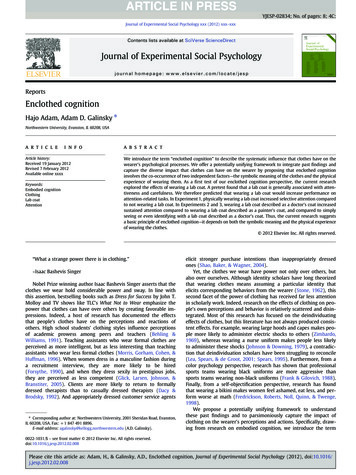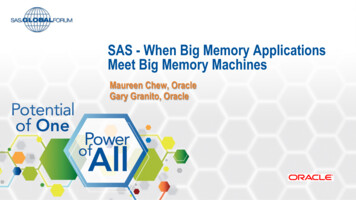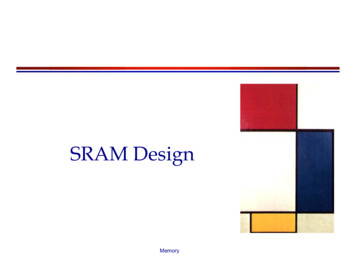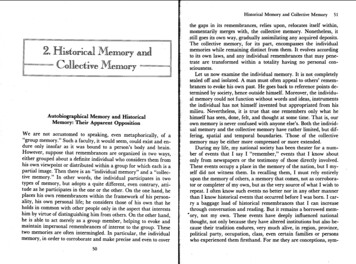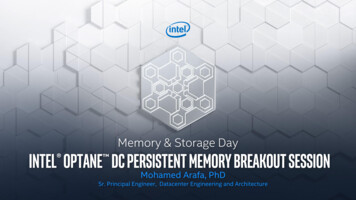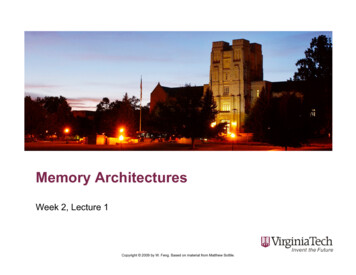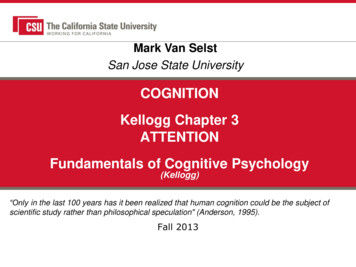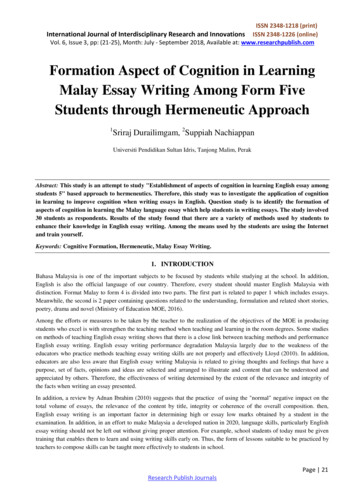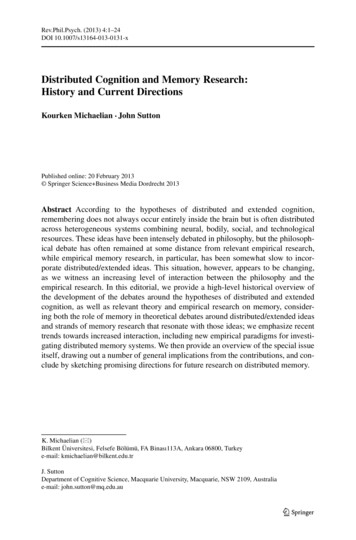
Transcription
Rev.Phil.Psych. (2013) 4:1–24DOI 10.1007/s13164-013-0131-xDistributed Cognition and Memory Research:History and Current DirectionsKourken Michaelian · John SuttonPublished online: 20 February 2013 Springer Science Business Media Dordrecht 2013Abstract According to the hypotheses of distributed and extended cognition,remembering does not always occur entirely inside the brain but is often distributedacross heterogeneous systems combining neural, bodily, social, and technologicalresources. These ideas have been intensely debated in philosophy, but the philosophical debate has often remained at some distance from relevant empirical research,while empirical memory research, in particular, has been somewhat slow to incorporate distributed/extended ideas. This situation, however, appears to be changing,as we witness an increasing level of interaction between the philosophy and theempirical research. In this editorial, we provide a high-level historical overview ofthe development of the debates around the hypotheses of distributed and extendedcognition, as well as relevant theory and empirical research on memory, considering both the role of memory in theoretical debates around distributed/extended ideasand strands of memory research that resonate with those ideas; we emphasize recenttrends towards increased interaction, including new empirical paradigms for investigating distributed memory systems. We then provide an overview of the special issueitself, drawing out a number of general implications from the contributions, and conclude by sketching promising directions for future research on distributed memory.K. Michaelian ( )Bilkent Üniversitesi, Felsefe Bölümü, FA Binası113A, Ankara 06800, Turkeye-mail: kmichaelian@bilkent.edu.trJ. SuttonDepartment of Cognitive Science, Macquarie University, Macquarie, NSW 2109, Australiae-mail: john.sutton@mq.edu.au
2K. Michaelian, J. Sutton1 Distributed Cognition and Memory ResearchWhen different people remember how to get to a particular place, or share their memories of an event they all experienced, or locate a specific and complex sequence offacts among some large body of data, they may employ significantly distinct methodsin achieving their aims. While some people just immediately remember the relevant material all by themselves, others will ask for help, either relying entirely ontheir peers or hoping to cross-cue each other’s recall; many will consult externalaids, whether general-purpose technologies or idiosyncratically-organized personalsystems; in turn, others may not manage the task at all until they put themselvesback into the right context, or re-enact a certain procedure or sequence of actions. Inordinary thinking about memory, the notion that the processes of remembering canbe thus hybrid, involving differently-balanced deployments of internal and externalresources, can seem unproblematic.From this point of view, it may seem arbitrary to restrict attention to processeswithin the individual brain: yet this has been the strategy of many long-standingtraditions in the philosophy, psychology, and cognitive science of memory (compareButterfill and Sebanz 2011 on individual and joint action). It has often been assumedthat remembering is exclusively a neural process, occurring inside an individual’sbrain; that whatever the precise nature of the memory trace which carries or is thevehicle of each enduring memory content, it is contained within and possessed bythat individual; that any psychological kind or kinds to be identified by the sciencesof memory will be wholly internal; and that external resources are at best cues ortriggers to the real memory processes inside the head.In philosophy, the most notorious challenge to these assumptions arises from AndyClark and David Chalmers’ paper “The Extended Mind” (Clark and Chalmers 1998).They argued that both cognitive processes (such as remembering) and standing cognitive states (such as memories) can, in certain circumstances, literally spread beyondthe boundaries of skull and skin. In resisting individualism about memory and cognition, Clark and Chalmers built their “active externalism” directly on an array ofearlier empirical and philosophical movements, which we survey briefly below. Thewidespread influence of their controversial and impressive paper has occasionallyled contemporary philosophers to neglect both that broader field of existing researchon distributed cognition and the methodological component of their project in favourof exclusive focus on metaphysical issues. A natural methodological consequenceof individualism is that psychology should be allied only with the neurosciences,that mind and memory are to be studied by way only of individual behaviour andindividual brains. In contrast, Clark called for “a new kind of cognitive scientificcollaboration involving neuroscience, physiology, and social, cultural, and technological studies in about equal measure” (Clark 2001a, p. 154). But his critics saw suchmoves as a misguided attempt “to turn psychology into a kind of anthropology orsociology or ecology; and it just won’t fit. There already are sciences whose topic ofinquiry is the interpersonal and environmental. . . . There is no room for an expandedpsychology, no motivation for it, and no need for it” (Butler 1998, p. 222). Ongoing debates over both metaphysical and methodological tensions, and especially their
Distributed Cognition and Memory Research: History and Current Directions3consequences for empirical research on memory, are the springboard for the eightpapers in this special issue of the Review of Philosophy and Psychology.1.1 What is Distributed Memory?By remembering, we can—fallibly, imperfectly—keep track of states of the worldand sequences of events, including our own actions. We can, more or less explicitly,use past experience to guide or direct present decisions and future plans. We canmaintain a more or less coherent and integrated sense of our own history and of ourplace in social groups. While some of these complex and interacting functions ofmemory are, arguably, unique to humans, they build on capacities for learning andtracking which are more widely shared across species. Whatever their evolutionaryhistory, activities of remembering in human beings are (as we noted above) notablydiverse, often involving not only multiple interconnected neural systems, but alsobodily practices and external resources of many distinctive kinds. Such is, at least,the view of theorists who see remembering as “distributed”, as spread over, coupledwith, situated among, or incorporating heterogeneous resources beyond the brain.Yet it is a striking feature of human memory that we sometimes remember facts,episodes, or procedures in isolation, while entirely alone, or independent of anyrelevant current stimuli. Our capacity thus to remember what is absent was oftenhighlighted by early classical theorists of the cognitive revolution (Miller et al. 1960;Anderson 1976), who saw memory as demonstrating that each individual carriesall the information we can recall around with us in the form of internal representations. While some theories of distributed cognition have been pitched as radicaland thoroughgoing critiques of such forms of cognitivism, in other cases they havebeen developed more as natural extensions, or as critiques of mainstream cognitivetheory from within. But in either case theories of distributed cognition have offeredmetaphysical and methodological challenges to standard forms of individualism andinternalism: they have claimed either that remembering does not occur within thebrain alone, or that it should not be studied by exclusive attention to neural processes,or both. They have therefore had to argue that even when memory appears to take usout of the current situation, in fact the processes involved can still often be distributedacross disparate resources (Sutton 2009).1.2 Distributed Cognition: Background and HistoryA full history of distributed cognition and memory research would recover conceptual links between three great precursors in the first half of the 20th century whoaddressed this challenge in different but arguably compatible ways: the English psychologist (Bartlett 1995/1932), the French social theorist (Halbwachs 1992), andthe Soviet developmental psychologist (Vygotsky 1978). But the modern history ofideas about distributed memory dates from the 1970s and especially the 1980s. Inthat period, for independent reasons in cognitive psychology, sociology, and developmental psychology respectively, the works of these three predecessors began tobe integrated afresh into mainstream debates (Sutton 2009). Bartlett’s account of
4K. Michaelian, J. Suttonindividual remembering as the context-dependent reconstruction of momentary patterns from fragmentary, interest-ridden traces and schemas was taken up by bothcognitivist and ecological psychologists interested in the limits and consequences ofconstructive processes (Neisser 1997; Saito 2000). A multifaceted “memory boom”in social and cultural theory brought Halbwachs’ difficult ideas about the socialframeworks of memory and the role of social groups in reconstructing the past backto the heart of the social sciences (Olick and Joyce 1998). And, as well as Vygotsky’sdirect and ongoing influence on developmental psychology, his accounts of thinkingand “self-instruction” were taken up by the “new connectionists”. In addition to theirthoroughly constructivist models of memory, one influential section of the 1986 volumes on Parallel Distributed Processing linked Vygotsky to a discussion of the roleof external representations in reasoning. To solve complex multiplication problems,for example, we use our trained-up, culturally-sanctioned skills to write down thesums in particular ways, manipulating and then iteratively processing environmental representations (Rumelhart et al. 1986, pp. 44–48). As well as turning problemsinto simpler pattern-matching or pattern-transformation tasks which we can performunaided, such systematic practices of (external) symbol processing are the source ofany capacities we develop to do mental arithmetic, or perform other complex symbolic operations, without those symbolic and environmental supports. The imaginedrepresentations or models on which we then come to be able to operate derive fromour experience with actual models in the external environment, which can thus beseen as “a key extension to our mind” (Rumelhart et al. 1986, p. 46).This connectionist movement was one of a number of independent developmentsin empirical, computational, and theoretical cognitive science which by the 1980ssaw researchers increasingly liberalize their conceptual and methodological toolkit,as classical individualist Artificial Intelligence failed to make progress as swiftly andsuccessfully as had been hoped (Boden 2006). Distributed cognition emerged froma range of traditions which were differently placed in relation to mainstream cognitive science. Alliances with dynamical systems theory arose, for example, within thecognitive sciences. Developmental and cultural psychologists had pushed further onVygotskian ideas about the role of adults in helping children negotiate the zone ofproximal development, until Bruner and colleagues introduced the notion of “scaffolding”. This was intended to capture the ways in which external resources (whetherphysical, technological, or social) can mould or orchestrate actions beyond a learner’scurrent level of unassisted performance (Wood et al. 1976; Greenfield 1984). Intothe 1990s, this tradition merged with developmental research on domains from motorperformance to reasoning couched in the framework of dynamical systems theory (Thelen and Smith 1994; Clark 1997, pp. 35–47). It also shaped a continuousbody of social-interactionist work on children’s language and memory, which arguedthat specific qualities of parents’ talk about the past with pre-schoolers plays directand constructive roles in sculpting their children’s autobiographical memory capacities (Nelson and Fivush 2004). Our more sophisticated capacities for thinking andremembering, on such views, soak in from the socially-available models to which ourbiological mechanisms are especially attuned.Other fields which had been in some ways more marginal during the earlier phasesof the cognitive revolution also contributed to a new focus, in the 1980s and early
Distributed Cognition and Memory Research: History and Current Directions51990s, on the rich interactions between thinkers and their environments, and on thecontexts in which cognitive processes occurred. Anthropology, education, media theory, and design had been to differing degrees “missing disciplines” (Boden 2006)in the putatively multidisciplinary project, despite their relevance to the study ofhuman thinking, remembering, problem-solving, learning, and communicating. Theorists in these domains, and in emerging hybrid disciplines such as human-computerinteraction (HCI), sought to integrate the new directions in cognitive theory with thesubstantial and independent bodies of empirical and ethnographic research in theirhome fields (Agre and Chapman 1989; Clancey 2009; Lave 1988; Norman 1993;Rogoff 1991; Rogoff and Lave 1984; Rogers 1997; Salomon 1993; Suchman 1987;Zhang and Norman 1994). The development of “distributed cognition” as both theoretical approach and method was pushed ahead most fully over this period by thecognitive anthropologist Edwin Hutchins and his colleagues at the University ofCalifornia, San Diego.1.3 Hutchins and ClarkIn a series of studies of practices of decision-making across domains such as navigation in both maritime and aviation settings, software development, and air trafficcontrol, Hutchins and his colleagues analysed flexible and intelligent action asinvolving the cooperation and coordination of disparate individual, interpersonal, andtechnological activities. In more or less stable organized settings, groups and artifactsform distributed cognitive systems which are collectively responsible for the emergent overall behaviour of the whole. The cognitive scientists’ aim then is to examinethe microprocesses of interaction across the diverse components of these distributedand heterogeneous cognitive systems, tracing for example the propagation and transformations of particular representational states across distinct (internal and external)media. Often no individual actor controls or even knows every part of the intelligentprocess of (for example) navigation, let alone possesses an internal blueprint or planof each of its component: expertise is not a property of individual agents, but is builtin to the constraints of the system.Hutchins published a forthright and striking exposition of distributed cognition,in the context of his cognitive ethnography of navigation on a US Navy frigate, inhis book Cognition in the Wild (Hutchins 1996). The framework was then broughtsharply to the attention of philosophers of cognitive science when Andy Clarkadopted it as a central plank in his rich synthesis of the new anti-individualist movements across the cognitive sciences, Being There: putting brain, body, and worldtogether again (Clark 1997). Clark saw distributed cognition as a natural extensionof the point made in much connectionist literature that order and systematicity inhuman cognition and action can derive in part from the stability of our environments, rather than as a direct product or reflection of exhaustively-specified internalrecipes. Cognition might thus be multiply distributed, both within neural networksand across bodies, artifacts, and social groups. As well as enthusiastically adopting Hutchins’ cognitive anthropological approach, Clark brought together evidenceand ideas from robotics, developmental psychology, dynamical systems theory, connectionist modelling, phenomenological philosophy, and from strands of work in
6K. Michaelian, J. Suttonbiology, neuroscience, linguistics, and economics in a dizzying integrative manifestofor an embodied and distributed multidisciplinary cognitive science. As in the caseof Hutchins, Clark’s visions of new agendas for cognitive science were nevertheless couched in terms of tracing the computational transitions across representationalstates, even if the transitions and states of interest were now often external. This hasoccasionally seen both Hutchins and Clark attacked as insufficiently radical by criticsof the very idea of cognitive science, who have seen them as exporting or projecting the apparatus of internalism onto the social and public realm: but on the otherhand it has arguably facilitated the gradual adoption of at least parts of the distributedcognition framework in mainstream cognitive science.As Hutchins and Clark have each continued to develop their research programs innew directions, there have recently been signs of some divergences concerning justhow and at which timescales culture and mind interact (Hutchins 2011; Clark 2011).But their earlier canonical presentations of distributed cognition have some furthercommon features which are worth noting here. Firstly, although both Hutchins andClark have been particularly interested in the specifically technological mediationof cognitive processes, sometimes focussing on highly sophisticated computationalartifacts, they both clearly intend the framework also to apply to other dimensionsof distributed cognitive systems, both noting that most complex real-world cognitivepractices involve social and interpersonal interaction in conjunction with technologies and physical systems. Secondly, in some contrast to the way the philosophicalliterature has developed in the wake of Clark and Chalmers’ defence of the extendedmind, both Hutchins and Clark took up the burden of showing that the primarycontribution of distributed cognition should come in the shape of the methodological difference it can make to the explanatory practices of the cognitive sciences.They each argued that the utility and productivity of the framework would be bestdemonstrated by its success in encouraging and assisting scientists to study changing interactions between neural, bodily, material, and social processes in drivingcognition and intelligent action (Clark 2001b; Hutchins 2005).Finally, the central route by which both Hutchins and Clark argued for distributedcognition was by stressing the disparate nature of the coordinated resources in adistributed cognitive system. Neural, bodily, physical, and social components ofsuch complex coupled systems need not be alike: rather, their distinctive featuresand capacities complement each other in combination so as to realize the relevantprocesses collectively. In particular, where the external resources in question are symbolic in nature, the representational formats and the computational dynamics of suchexternal symbol systems will typically differ from whatever states and processes areat work in the brain. Since both Hutchins and Clark worked within a broadly connectionist understanding of cognitive neuropsychology, they did not argue for any deepisomorphism of structure or function between neural and external resources: externalresources are alien but complementary, as Clark put it, to the brain’s style of storageand computation, so “the brain need not waste its time replicating such capacities.Rather, it must learn to interface with the external media in ways that maximallyexploit their particular virtues” (Clark 1997, p. 220; compare Clark 1998, p. 99). Tothe extent that philosophical work on extended cognition has focussed primarily onissues about the parity of, or functional isomorphism between, internal and external
Distributed Cognition and Memory Research: History and Current Directions7resources (Adams and Aizawa 2008; Rupert 2009; Sprevak 2009; Wheeler 2011), ithas arguably thus shifted the central line of thought away from the original directionsof argument for distributed cognition.1.4 Memory Research and Distributed CognitionBoth Hutchins and Clark discussed remembering at many points in these works ofthis period, but it was not part of their projects to engage in detail, either criticallyor constructively, with existing psychological views on the forms and mechanisms ofhuman memory. Research in the sciences of memory, indeed, had a quite independenthistory in these decades, often somewhat apart from other mainstream movements inthe cognitive sciences. It was only slowly, for example, over the course of the 1980sand especially the 1990s, that autobiographical (or personal or experiential) memory became a widely acceptable topic in cognitive psychology (Conway 1990). Andwhile debates about ecological validity in memory research had been particularlyheated (see Barnier 2012), one of their effects was to forge tight links between basicexperimental work on memory in the laboratory, and applied or “everyday” memory research: the influential Society for Applied Research in Memory and Cognition(SARMAC), for example, was founded in 1994 after the 3rd major internationalconference on Practical Aspects of Memory.In certain respects, then, some methodological and institutional preconditionswere in place early for potential interactions between cognitive approaches to memory and the distributed cognition frameworks. However, in practice, these interactionswere slow to build. We can see this by sketching the fate of two theoretical initiativeswhich might have had earlier influence on mainstream psychologies of memory thanthey did. Daniel Wegner and his colleagues, in a series of ambitious papers publishedin the 1980s, developed a theory of Transactive Memory Systems (Wegner 1987;Wegner et al. 1985). Focussing especially on long-term intimate couples, Wegner andcolleagues argued that over the course of a rich shared history, dyads and other smallgroups can develop complex forms of cognitive interdependence. A transactive memory system, in Wegner’s terms, is a set of individual memory systems along with theestablished systems of communication between those individuals. Transactive memories reside in the memories of both individuals when considered as a combinedsystem, given their shared awareness of the way information is distributed within thegroup, which can take more or less differentiated and specialized forms. AlthoughWegner suggested a number of natural directions for testing these ideas, they hadsurprisingly little influence in the cognitive or social psychology of memory, insteadbeing taken up for many years almost exclusively in organizational psychology andin studies of memory and performance in work groups and teams. As a number ofpapers in this special issue show, however, transactive memory systems theory hastaken on a new lease of life in recent years (see especially Theiner and Tollefsen,Dale, and Paxton). It has come back into cognitive psychology, in part, after beingdiscussed in philosophy and social ontology (Tollefsen 2006; Barnier et al. 2008),while Wegner and colleagues have extended their own original focus on socially distributed remembering to look at our cognitive interdependence with the extendedbodies of information available to us online (Sparrow et al. 2011).
8K. Michaelian, J. SuttonA second, distinct line of thought in which human memory was seen within something like a distributed cognition framework was in Merlin Donald’s book Originsof the Modern Mind (Donald 1991). Donald coined the word “exogram”, by analogywith the brain’s “engrams” or neural memory traces, to describe the external symbolswhich we as a species have come to combine, manipulate, and rely on. Changes insuch external symbol systems since the upper Palaeolithic period have dramaticallyaltered the capacity and operation of human memory (Donald 1991, pp. 308–333;Donald 1998). Identifying certain common features across the diverse history ofexternal representations—body markings, grave decorations, hieroglyphics, maps,musical scores, writing systems, architectural diagrams and so on—Donald focussedour attention on the new cognitive profiles that characterise creatures (and societies ofcreatures) who can draw on these exograms in addition to neural engrams. Thoughtsand memories, for example, become more durable and more easily transmissible andreformattable across media and contexts and are plugged in to vastly larger databasesof inherited knowledge (Donald 1991, pp. 314–319). In an important early philosophical development of ideas about distributed cognition, Mark Rowlands built onDonald’s work to argue that much of human memory is essentially (not accidentally) environment-involving, and primarily consists in our ability to interface witha range of different collective memory networks (Rowlands 1999, pp. 119–147, alsodrawing on important work by Rubin 1995). Yet, again, Donald’s primary influenceswere outside the mainstream cognitive sciences of memory, as he was instead drawnin for example to extensive debates in cognitive archaeology with radical enactivistsand phenomenologists who thought that his focus on symbolic systems was still fartoo close to classical cognitivism (Renfrew and Scarre 1998; Malafouris 2004; seealso Sutton 2008). This is a continuing dynamic in studies of distributed cognition,with more ecumenical attempts to nudge mainstream cognitive theory and practiceout of its individualist methods rubbing up against various waves of much more critical anti-representationist movements. Theorists with backgrounds in long-standingtraditions of Wittgensteinian, phenomenological, direct realist, processual, or dynamical/enactivist critiques of the cognitive scientific enterprise as a whole have shownsome ambivalence towards distributed cognition, which is not revolutionary enoughfor their liking; such issues are visible in at least two of the papers in this specialissue (Dahlbäck et al., Loader).But to return briefly to mainstream paradigms in the sciences of memory, furtherimpetus towards an integration of distributed cognition into the experimental cognitive psychology of memory has come in recent years, by way of fruitful debates andimprovements in a number of specific experimental paradigms. Significant examplesare the collaborative recall paradigm (Weldon 2000; Harris et al. 2008; Rajaram andPereira-Pasarin 2010), and work on socially-shared retrieval-induced forgetting (Cucet al. 2007, and see the paper by Fagin, Yamashiro, and Hirst in this special issue).Where some other experimental work on false memory has painted social interaction as primarily a source of misinformation or memory contagion, work in theseparadigms has encouraged careful exploration of conditions under which systematicreliance on external (especially social) resources transforms the processes and products of memory, for better or worse (Meade et al. 2009; Barnier 2010; Stone et al.2012). The fact that there are natural extensions of these paradigms to study memory
Distributed Cognition and Memory Research: History and Current Directions9processes in ageing individuals and couples is another advantage. Clark and Chalmersrested their case for extended cognition partly on the notorious Otto thought experiment, in which the systematic use of external aids transforms the memory tasksand processes of a man suffering memory decline: the thought experiment was notintended to substitute for investigation of the actual compensatory roles of technologies and other people in scaffolding us against memory loss (Harris et al. 2011;Drayson and Clark 2013; and see the paper by Dahlbäck, Kristiansson, and Stjernbergin this special issue). Partly as a result of these recent movements, a number of wellestablished cognitive, developmental, and neuropsychologists of memory now haveactive research interests in distributed cognition and related theoretical frameworks:in a recent review paper in the Annual Review of Psychology, William Hirst and Gerald Echterhoff discuss work by Hutchins, Clark, and others, noting that “the extendedmind approach . . . places the study of conversational remembering front and centerin a way more traditional approaches to the study of memory do not” (Hirst andEchterhoff 2012, p. 58).2 Rationale for the Special IssueIn planning this special issue, we sought to reinstate the breadth of topics and concerns apparent in this historical sketch to contemporary debates about memory anddistributed cognition. We wanted to build both on our own previous work (Barnieret al. 2008; Michaelian 2012a; Sutton 2010), and on prior special issues of journalssuch as Philosophical Psychology (Sutton 2006) and Memory (Barnier and Sutton2008). Earlier versions of three of the eight papers in the current issue were presented as part of a symposium on memory and distributed cognition at ICOM-5, the5th International Conference on Memory, at the University of York (UK) in August2011. The largest of the ICOM meetings that have taken place every five years since1991, this conference featured over 500 talks and 250 poster presentations. The vastmajority of research presented at ICOM-5 was firmly anchored in the various fieldsof mainstream experimental psychology: cognitive, clinical, developmental, social,personality, and comparative psychology, for example, as well as cognitive neuroscience and neuropsychology. But in addition to the small minority of philosophersat the conference, there was a striking level of new interest among experimentalpsychologists too in the ways that remembering has not just neural but also bodily,social, and technological dimensions. To enrich such cross-disciplinary movements,we suggest that philosophers of memory and cognition need to immerse themselvesfully in contemporary psychological research, as well as in the methods and assumptions of other disciplines that can potentially offer empirical data on memory, fromanthropology to hist
umes on Parallel Distributed Processing linked Vygotsky to a discussion of the role of external representations in reasoning. To solve complex multiplication problems, for example, we use our trained-up, culturally-sanctioned skills to write down the sums in particular ways, manipulating and then iteratively processing environmen-
